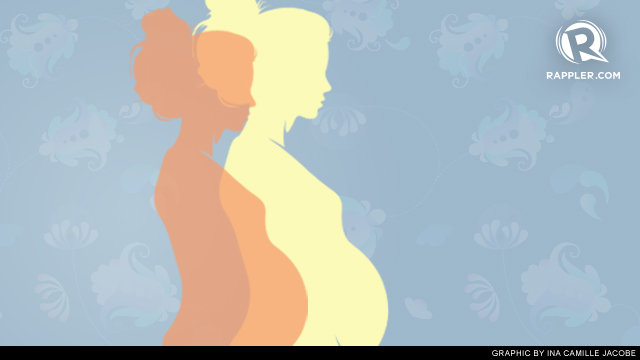SUMMARY
This is AI generated summarization, which may have errors. For context, always refer to the full article.

MANILA, Philippines – The 7-month old baby in Mary Ann de Lima’s womb is her second child, and she wants to name him Kean Carl.
She wants to name him herself, take care of him herself, and see him grow up like his 5-year-old brother, Rhican Criz.
Mary Ann fears death. She heard 40 mothers who live in Quezon City died last year during childbirth, and she refuses to be part of this year’s numbers.
That is why she’s giving birth in a health facility this time around, unlike 5 years ago, when she gave birth at home.
“‘Yun kasi ‘yung time na talagang [may] kakulangan sa pera, ‘di siya napag-ipunan…. ‘Yung time na ‘yun bata pa kaming [mag-asawa],” she said. (It was a time when we didn’t have enough money. We were not able to save up for the pregnancy. My husband and I were young then.)
She did not suffer any complications during the home birth, but she doesn’t want to risk it anymore.
“Magiging panatag ako once na sa ospital ako manganak kasi kahit ano’ng mangyari sa akin…malalaman ko kung may ano ‘yung baby ko kaagad, kung normal ba, mailalabas ko ba,” she said. (I will be at ease once I give birth in the hospital because whatever happens to me…I will now if my baby is normal, if I can deliver him.)
No more home births in QC
Even if she wanted to give birth at home, it will be tough to do so where she lives.
In Quezon City, an ordinance was passed in 2012 prohibiting home births. It also prohibited traditional birth attendants from delivering babies, while requiring professional health practitioners to perform deliveries only in health facilities.
According to UNICEF, Quezon City is among the most disadvantaged areas in the Philippines, with mothers and newborns living under the highest vulnerabilities of conflict, disaster, and deprivation. Other areas include Sultan Kudarat and North Cotabato.
The Quezon City ordinance was meant to prevent the 3 major causes of maternal mortality: hypertension, hemorrhage, and unsafe abortion.
“These problems can be prevented and can be addressed through adequate medical care such as the presence of skilled birth attendants, emergency obstetric care, when necessary, and access to family planning services,” the ordinance read.
In 2013, the highest cause of maternal death in Quezon City was hypertension, Medical Officer Dr Nimfa Zarate said. Obstetric hemorrhage came in second.
Interestingly, there were zero cases of death due to pregnancy-related infection, although 7 mothers still died while giving birth at home.
“The reason why there are still home deliveries is that they can talk to the midwife [so] that they can pay in installments. They don’t realize they will be in more danger if they deliver at home,” Quezon City health officer Dr Antonieta Inumerable said.
UNICEF said almost half (45%) of births in the Philippines are still delivered at home. Of these, 27% are attended by traditional birth attendants or hilot.
Helping midwives

Inumerable said their experience points to more and more private midwives being profit-oriented than service-oriented during deliveries. This forced the city government to pass the ordinance.
The city also has put up Safe Birth clinics, where midwives can bring the mothers. This way, childbirth is still facility-based and midwives can still practice their profession and earn a living.
Since the ordinance was passed, home deliveries have gone down from 12% to 6%. But out of 800 home deliveries, 500 of them are still being done by hilot, Inumerable said.
These attendants are already being regulated. They are either offered alternative livelihood or trained as community health workers. (READ: Are home births being banned?)
WHO protocols
On Thursday, February 27, Johnson and Johnson Philippines turned over 500 survival kits it developed to save the lives of mothers and newborns. The company, including its employees, raised funds over the last 6 months to give a total of 750 kits to Batasan and Betty Go Lying-In Clinics, both in Quezon City.
The kit includes oxytocin, which helps induce womb contractions and easing childbirth, as well as baby garments important during the skin-to-skin contact between the mother and the baby.
Uninterrupted skin-to-skin contact is among the protocols of Unang Yakap, or the Essential Newborn Care Protocol prescribed by the World Health Organization (WHO) and institutionalized by the Department of Health to improve health care services for babies during the first critical hours.
Through the survival kits, the Quezon City Health Office hopes to encourage more mothers to choose a facility-based delivery. – Rappler.com
Add a comment
How does this make you feel?
There are no comments yet. Add your comment to start the conversation.